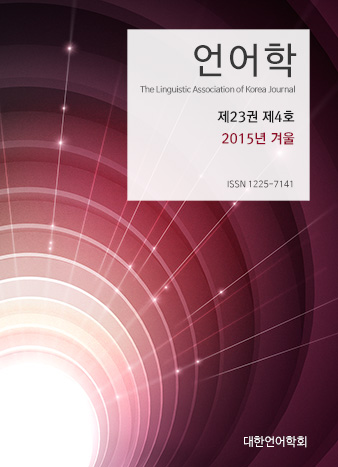대한언어학회 전자저널

23권 4호 (2015년 12월)
- Non-native Acquisition of Phonotactic Constraints: A Study of English Pronunciation by Korean Learners
-
Jong-mi Kim
Pages : 91-113
Abstract
Kim, Jong-mi. (2015). Non-native Acquisition of Phonotactic Constraints: A Study of English Pronunciation by Korean Learners. The Linguistic Association of Korea Journal 23(4), 91-113. A principled basis for the non-native acquisition of phonotactics is proposed in light of the phenomena that Korean native speakers adapt to the foreign phonological well-formedness of English as the target language of learning. We discuss five types of phonotactic adaptation, namely, avoidance of neutralization, avoidance of assimilation, preservation of contrasts, progressive assimilation, and a preference for insertion over deletion. Of these five types, progressive assimilation has been little reported in literature, and newly tested in this study by means of production and perception experiments as well as a spectrographic analysis. It is concluded that the principles of enhancement and faithfulness predict the phonotactic adaptation in non-native speech and the overlap principle lends little.
Keywords
# non-native acquisition # phonotactics # Korean English # avoidance of assimilation # progressive assimilation # enhancement # faithfulness
References
- Altenberg, E. (2005). The judgment, perception, and production of consonant clusters in a second language. International Review of Applied Lingusitics, 43, 53-80.
- Broselow, E. (1984). An investigation of transfer in second language phonology. International Review of Applied Linguistics, 22, 253-269.
- Broselow, E., Chen, S. & Wang, C. (1998). The emergence of the unmarked in second language phonology. Studies in Second Language Acquisition, 20(2), 261-280.
- Carr, P. (2008). A Glossary of Phonology. Edinburgh University Press.
- Eckman, F. R. (2004). From phonemic differences to constraint rankings: Research on second language phonology. Studies in Second Language Acquisition, 26, 513-549.
- Flege, J. E. & V. Wang. (1989). Native phonotactic constraints affect how well Chinese subjects perceive the word-final English /t/-/d/ contrast. Journal of Phonetics, 17, 299-315.
- Hancin-Bhatt, B. (2008). Second language phonology in optimality theory. In J.G. Hansen Edwards & M.L. Zampini (Eds.), Phonology and Second Language Acquisition. Amsterdam/Philadelphia: John Benjamins.
- Hayes, B. (2009). Introductory Phonology. Malden, MA: Blackwell Publishing.
- Heo, Y-J. (2010). Assimilation rules apply progressively in L2 speech: The case of Korean liquid rules in English words. Proceedings of the 15th International Conference of Pan-Pacific Association of Applied Linguistics. Hanyang Women’s University, Seoul, Korea. August 17-19. pp. 287-292.
- Keyser, S. J. & K. N. Stevens. (2006). Enhancement and overlap in the speech chain, Language, 82(1), 33-63.
- Kim, J.-M. (2009). Insertion preferred to deletion in learner speech: A study of Korean English. Jungang Journal of English Language and Literature, 51(3), 101-124.
- Kim, J-M. (2015). Enhancement and Faithfulness in Non-native Phonology. Presented at the CUNY Phonology Forum Conference on Multilingual Phonology. City University of New York. January 15-16.